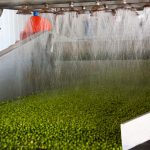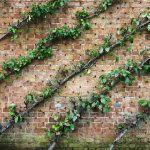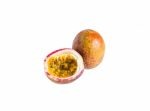Guabiroba (Campomanesia xanthocarpa O. Berg) is a tropical forest tree or shrub which grows up to 20m tall and is native to Argentina, Paraguay and Brazil (Marchiori and Sobral, 1997).
It produces a very smooth dark yellow fruit that resembles a guava and is claimed to have good juicing properties. Total soluble solids range from 9 to 15° Brix. The average fruit measures 1.5 cm to 3 cm. In sensory terms it has a strong flavour and aroma reminiscent of citrus or guava fruits in particular.
The leaves and stem bark are traditionally used in South America to treat dysentery, intestinal problems, fever (antipyretic), diarrhoea and liver (hepatic) problems (Pio Corrêa, 1952; Barroso, 1991; Cravo, 1994).
Fruit extracts have been demonstrated in pharmacological studies to inhibit the enzyme xanthine oxidase (Theoduloz et al., 1988). It has both antimicrobial and antiulcerogenic activities in mice (Markman et al., 2004) without being toxic.
The essential oil from the leaves contains E-nerolidol (28.8%) and linalool (17.2%) (Limberger et al., 2001). Other chemical componentry includes a variety of flavonoids quercetin, myricetin, quercitrin and rutin (Schmeda-Hirschmann, 1995), and also a variety of saponins and tannins (Markman et al., 2004) which have all been ascribed medical properties.
References
Barroso, G.M. (1991) “Sistemática de Angiospermas do Brasil”, vol. 2. Universidade Federal de Viçosa, Viçosa, pp. 114-33.
Cravo, A.B. (1994) “Frutas e ervas que curam: panacéia vegetal”, 4ª ed. Hemus, São Paulo
Limberger, R.P., M.A. Apel, M. Sobral, P.R.H. Moreno, A.T. Henriques, C. Menut (2001) Chemical composition of essential oils from some Campomanesia species (Myrtaceae) J. Essent. Oil Res. 13 pp. 113-5.
Marchiori, J.N.C. & M. Sobral (1997) “Dendrologia das Angiospermas – Myrtales”. (Santa Maria: Editora UFSM).
Markman, B.E.O., E.M. Bacchi, Kato, E.T.M. (2004) Antiulcerogenic effects of Campomanesia xanthocarpa. J. Ethnopharmacol. 94 pp. 55-7.
Pio Corrêa, M. (1952) “Dicionário das plantas úteis do Brasil e das exóticas cultivadas” vol. 3. Imprensa Nacional, Rio de Janeiro.
Schmeda-Hirschmann, G. (1995). Flavonoids from Calycorectes, Campomanesia, Eugenia and Hexachlamys species. Fitoterapia, 66(4),pp. 373-374.
Theoduloz, C., L. Franco, E. Ferro, G. Schmeda-Hirschmann (1988) Xanthine oxidase inhibitory activity of Paraguayan Myrtaceae J. Ethnopharmacol. 24 pp. 179-183.



I had this guarbiroba as juice in Argentina not that long ago. I thought I was drinking guava because it tasted so similar. Could I get this in the US ? I looked in Whole Foods but it’s something most people have never heard of. I do a bit of fruit juice product development for a small business in Arizona and I’m thinking it could be a new fruit for our marketplace.